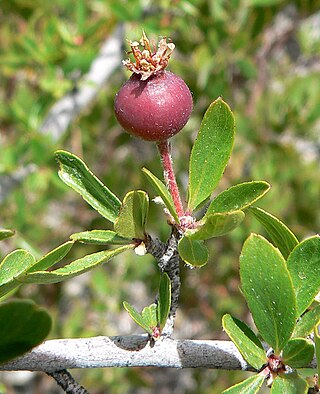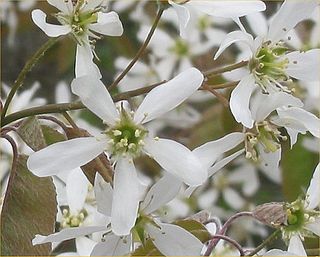
Rosaceae, the rose family, is a medium-sized family of flowering plants that includes 4,828 known species in 91 genera.

The MaloideaeC.Weber was the apple subfamily, a grouping used by some taxonomists within the rose family, Rosaceae. Recent molecular phylogenetic evidence has shown that the traditional Spiraeoideae and Amygdaloideae form part of the same clade as the traditional Maloideae, and the correct name for this group is Amygdaloideae. Earlier circumscriptions of Maloideae are more-or-less equivalent to subtribe Malinae or to tribe Maleae. The group includes a number of plants bearing commercially important fruits, such as apples and pears, while others are cultivated as ornamentals.

Amygdaloideae is a subfamily within the flowering plant family Rosaceae. It was formerly considered by some authors to be separate from Rosaceae, and the family names Prunaceae and Amygdalaceae have been used. Reanalysis from 2007 has shown that the previous definition of subfamily Spiraeoideae was paraphyletic. To solve this problem, a larger subfamily was defined that includes the former Amygdaloideae, Spiraeoideae, and Maloideae. This subfamily, however, is to be called Amygdaloideae rather than Spiraeoideae under the International Code of Nomenclature for algae, fungi, and plants as updated in 2011.

Aronia is a genus of deciduous shrubs, the chokeberries, in the family Rosaceae native to eastern North America and most commonly found in wet woods and swamps. The genus Aronia is considered to have 3 species. The most common and widely used is Aronia melanocarpa which emerged from Eastern North America. The lesser known Aronia arbutifolia and the hybrid form of the abovementioned species called Aronia prunifolia were first cultivated in Central and Eastern North America. In the eighteenth century, the first shrubs of the best-known species Aronia melanocarpa reached Europe where they were first cultivated in Scandinavia and Russia.

Rubus caesius is a Eurasian species of dewberry, known as the European dewberry. Like other dewberries, it is a species of flowering plant in the rose family, related to the blackberry and raspberry. It is widely distributed across much of Europe and Asia from Ireland and Portugal as far east as Xinjiang Province in western China. It has also become sparingly naturalized in scattered locations in Argentina, Canada, and the United States.

Rhodotypos scandens, the sole species of the genus Rhodotypos, is a deciduous shrub in the family Rosaceae, closely related to Kerria and included in that genus by some botanists. It is native to China, Korea, possibly also Japan.

Potentilla reptans, known as the creeping cinquefoil, European cinquefoil or creeping tormentil, is a flowering plant in the family Rosaceae.

Potentilla sterilis, also called strawberryleaf cinquefoil or barren strawberry, is a perennial herbaceous species of flowering plant in the rose family, Rosaceae. It is native to Europe.

Mespilus, commonly called medlar, is a monotypic genus of flowering plants in the family Rosaceae containing the single species Mespilus germanica of southwest Asia. It is also found in some countries in the Balkans, especially in Albanian regions. A second proposed species, Mespilus canescens, discovered in North America in 1990, proved to be a hybrid between M. germanica and one or more species of hawthorn, and is properly known as ×Crataemespilus canescens.

Holodiscus is a genus of flowering plants in the family Rosaceae, native to the Americas, from southwestern British Columbia, Canada and the western United States south to Bolivia.

Physocarpus, commonly called ninebark, is a genus of flowering plants in the family Rosaceae, native to North America and northeastern Asia.

Peraphyllum is a monotypic genus of flowering plants in the rose family, containing the single species Peraphyllum ramosissimum, commonly known as the squaw apple or wild crab apple.

Gillenia is a genus of two species of perennial herbs in the family Rosaceae, Gillenia stipulata and Gillenia trifoliata. Common names for plants in this genus include: Bowman's root, Indian-physic, American ipecac. This genus is endemic to dry open woods with acidic soils in eastern North America. Both plants are subshrubs with exposed semi-woody branches and serrated leaves; the larger lower leaves are divided into palmately arranged leaflets. Plants bloom in May, June, or July; blooms are composed of five slender white petals which are loosely arranged and typically appear slightly twisted and limp as if they were wilted. The flowers mature into small capsules. G. stipulata and G. trifoliata are often planted as ornamentals and used in herbal medicine.

Amelanchier canadensis is a species of Amelanchier native to eastern North America in Canada from Newfoundland west to southern Ontario, and in the United States from Maine south to Alabama. It is largely restricted to wet sites, particularly on the Atlantic coastal plain, growing at altitudes from sea level up to 200 m.

Sibbaldiopsis is a genus in the plant family Rosaceae. This genus only contains a single species: Sibbaldiopsis tridentata, formerly Potentilla tridentata. Commonly, its names include three-toothed cinquefoil, shrubby fivefingers, and wineleaf. Systemic phylogenetic work has placed S. tridentata within Sibbaldia as Sibbaldia retusa.

Prunus tenella, the dwarf Russian almond, is a species of deciduous shrub in the genus Prunus, native to steppes of Eastern Europe and Western Siberia, as well as dry open sites of Caucasus, Western and Central Asia.
Crataegus visenda is a species of hawthorn from the southeastern United States, in Alabama, Florida, and Georgia. It is a large shrub or small tree to 10 m tall. It has been considered as a synonym of Crataegus flava Aiton

The Maleae are the apple tribe in the rose family, Rosaceae. The group includes a number of plants bearing commercially important fruits, such as apples and pears, while others are cultivated as ornamentals. Older taxonomies separated some of this group as tribe Crataegeae, as the Cydonia group, or some genera were placed in family Quillajaceae.

Malinae is the name for the apple subtribe in the rose family, Rosaceae. This name is required by the International Code of Nomenclature for algae, fungi, and plants, which came into force in 2011 for any group at the subtribe rank that includes the genus Malus but not either of the genera Rosa or Amygdalus. The group includes a number of plants bearing commercially important fruits, such as apples and pears, while others are cultivated as ornamentals.

Turgenia is a genus of flowering plants in the family Apiaceae, containing up to seven species. The genus resembles Caucalis. False carrot is a common name for plants in this genus.


















